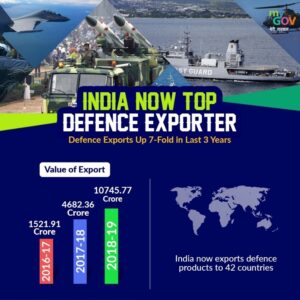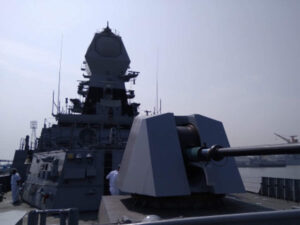India, known for its rich history and diverse culture, is emerging as a formidable player in the global defense exports market. Over the years, the country has significantly bolstered its defense capabilities and transformed itself from a major arms importer to a reliable exporter of defense equipment and technology. India’s defense exports have not only contributed to its economic growth but also strengthened its strategic partnerships with various nations worldwide. In this article, we explore India’s journey as a defense exporter, its achievements, challenges, and the potential it holds for the future.
A Paradigm Shift: From Defense Importer to Exporter:
For decades, India heavily relied on foreign nations for its defense requirements, making it one of the world’s largest arms importers. However, recognizing the need to enhance self-reliance and reduce dependency on other countries, India formulated policies to encourage domestic defense production. This shift was fueled by a desire to modernize the armed forces, bolster national security, and stimulate the country’s industrial growth.

The Factors Driving India’s Defense Exports:
Several factors have contributed to the rapid growth of India’s defense exports:
- Indigenous Defense Capabilities: India has made significant progress in developing its indigenous defense industry. This includes the production of a wide range of military equipment, such as aircraft, naval vessels, armored vehicles, small arms, and communication systems. Indigenous development has not only reduced imports but also enabled India to offer technologically advanced solutions to international customers.
- Government Support and Reforms: The Indian government has introduced policy reforms and initiatives like “Make in India” to promote domestic defense manufacturing and attract foreign investments. These measures have provided a conducive environment for defense companies to thrive and expand their export potential.
- Competitive Pricing and Quality: India’s defense products have become increasingly competitive in terms of pricing and quality. This has led to growing interest from foreign buyers, particularly from developing countries looking for cost-effective yet reliable defense solutions.
- Strategic Partnerships: India has actively sought strategic partnerships and collaborations with various nations to boost its defense exports. By jointly developing and producing defense equipment, India has gained access to new markets and technologies.
Achievements in Defense Exports:
India’s journey as a defense exporter has been marked by several significant achievements:
- Light Combat Aircraft (LCA) Tejas: The indigenously developed Tejas, a multi-role supersonic fighter aircraft, has been one of India’s most successful defense exports. It has garnered interest from several countries, signifying India’s potential as a competent aerospace exporter.

- BrahMos Missile System: Developed jointly with Russia, the BrahMos supersonic cruise missile system has gained international acclaim for its precision and lethality. Several countries have expressed interest in acquiring this missile system, further solidifying India’s position in the defense market.

- Radar Systems and Electronic Warfare Equipment: India has been exporting radar systems and electronic warfare equipment, showcasing its prowess in advanced defense technologies.

- Naval Vessels and Coastal Surveillance Systems: India’s shipbuilding industry has garnered interest from various countries, especially for patrol vessels, offshore patrol vessels, and coastal surveillance systems.

Challenges and the Road Ahead:
While India’s defense exports have seen remarkable growth, some challenges persist:
- Stringent Export Control Regimes: Many advanced defense technologies are subject to strict export controls by the supplier nations. India must navigate these regulations while expanding its export portfolio.
- Competition from Established Players: The global defense market is highly competitive, with well-established players dominating the industry. India must continuously innovate and offer unique value propositions to gain a competitive edge.
- Quality Assurance and After-Sales Support: Ensuring consistent quality and providing reliable after-sales support are critical for building trust among international customers.
- Political and Geopolitical Considerations: Defense exports can be influenced by political and geopolitical factors, making it essential for India to maintain a balanced approach in its international relationships.
Despite these challenges, the future for India’s defense exports looks promising. As the country continues to invest in research and development, enhance its manufacturing capabilities, and forge strategic partnerships, it will likely strengthen its position as a rising global player in the arms trade. By exporting defense equipment and technology, India not only strengthens its own security but also fosters collaborative defense solutions and partnerships worldwide. As long as India maintains its commitment to innovation, quality, and reliability, the journey of India’s defense exports will remain on a trajectory of growth and success.



